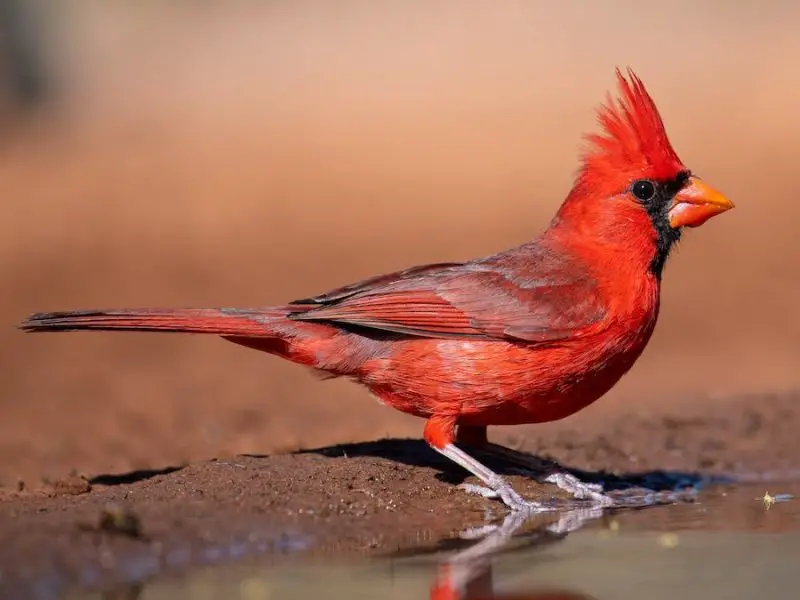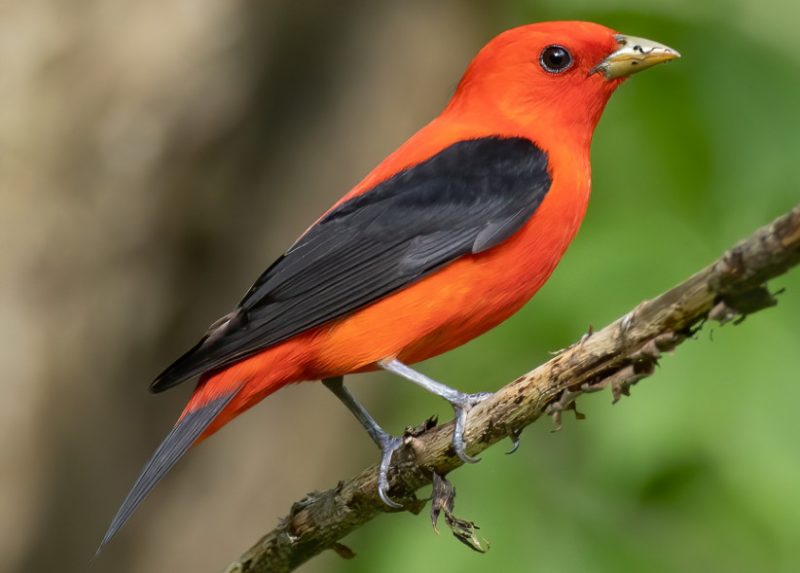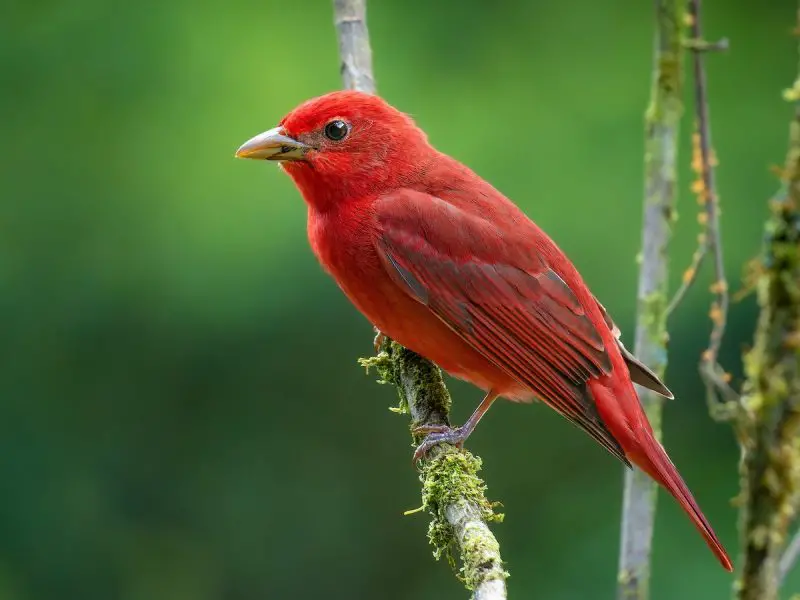If we talk strictly about true cardinals, Michigan is home to just one species: the Northern Cardinal. This striking bird, with its bright red plumage and cheerful song, is a familiar sight across the state’s backyards, parks, and woodlands. It is one of the most beloved birds in North America and remains a year-round resident in Michigan.
However, birdwatchers may sometimes come across other red-plumaged species that are not true cardinals but share a similar appearance. The most common of these is the Scarlet Tanager, which arrives in Michigan during the summer months to breed in mature forests. Its brilliant red body and contrasting black wings often cause it to be mistaken for a cardinal by casual observers.
In rare cases, the Summer Tanager may also appear in Michigan, usually as a stray during migration. While uncommon, its all-red male plumage makes it easy to confuse with the Northern Cardinal. Together, these birds add to the diversity of red songbirds in Michigan, offering birdwatchers both familiar and surprising encounters.
Different Types of Cardinals Found in Michigan
Northern Cardinal (Cardinalis cardinalis)

The Northern Cardinal is the only true cardinal species found in Michigan and one of the most recognizable birds in North America. Males display brilliant red plumage with a striking black mask around the face, while females are a warm brown with red tinges on the crest, wings, and tail. Both sexes share the characteristic crest and strong orange-red beak, which make identification simple even for beginner birdwatchers.
In terms of size, Northern Cardinals measure about 8–9 inches in length, with a wingspan of 10–12 inches, making them medium-sized songbirds. They are often seen perched in shrubs, low trees, or near feeders, where they remain highly visible due to their vibrant colors. Their sturdy bill is well-adapted for cracking seeds, though they also consume insects and fruits throughout the year.
Northern Cardinals are well known for their melodic songs and calls. Males sing to establish territories and attract mates, while females also sing—something unusual among North American songbirds. Their common “cheer-cheer-cheer” or “birdy-birdy-birdy” whistles are familiar sounds in Michigan’s neighborhoods and parks, especially in spring and summer.
Behaviorally, Northern Cardinals are non-migratory birds that remain in Michigan year-round, even enduring the harsh winters. They are highly territorial during breeding season but may form loose flocks in colder months. Cardinals are also frequent visitors to backyard feeders, preferring sunflower seeds and suet.
Their habitats range from suburban gardens to forest edges and open woodlands. In Michigan, they thrive wherever there is dense shrub cover for nesting and a reliable food source. Because of their beauty and adaptability, Northern Cardinals have become one of the most cherished and commonly observed birds in the state.
Scarlet Tanager (Piranga olivacea)

Although not a true cardinal, the Scarlet Tanager is a summer resident in Michigan that often causes confusion due to its vivid red plumage. Adult males are brilliant red with striking black wings and tail, making them appear similar to Northern Cardinals at a distance. Females and immature birds, however, are olive-yellow, which provides camouflage in the dense forest canopy where they spend most of their time.
Scarlet Tanagers are medium-sized songbirds, measuring around 6.5–7 inches in length with a wingspan of about 10–11 inches. Unlike Northern Cardinals, they prefer staying high in the treetops, making them more challenging to spot despite their bright coloration. Their slightly hooked bill is adapted for catching insects, which form the bulk of their diet during the breeding season.
The song of the Scarlet Tanager is a distinctive, burry warble often compared to a robin’s song but more hoarse. Their call note is a sharp “chip-burr,” which helps birders identify them when they remain hidden among leaves. Because of their canopy-dwelling habits, they are often heard before they are seen.
In Michigan, Scarlet Tanagers arrive in May to breed and stay through the summer months before migrating back to South America in the fall. They are most commonly found in mature deciduous forests, where they prefer large tracts of woodland that provide safe nesting sites away from predators.
Their presence adds vibrant flashes of color to Michigan’s forests during summer. Observing a Scarlet Tanager is considered a rewarding experience for birdwatchers, especially since these birds are less conspicuous and far more elusive than the widespread Northern Cardinal.
Summer Tanager (Piranga rubra)

The Summer Tanager is a rare visitor in Michigan, but its striking appearance often causes excitement among birdwatchers lucky enough to spot one. Adult males are entirely red from head to tail, lacking the black wings of the Scarlet Tanager, which gives them an even more cardinal-like appearance. Females and young birds are yellowish overall, sometimes with hints of orange or red as they mature.
In size, Summer Tanagers are similar to Scarlet Tanagers, measuring around 6.5–7 inches long with a wingspan of about 11 inches. Their beaks are slightly larger and more robust, well-suited for capturing and crushing insects. This species is especially famous for preying on bees and wasps, which they skillfully catch and kill by rubbing the stinger off before eating.
The song of the Summer Tanager is sweet and melodic, resembling that of a robin but more musical and less harsh than the Scarlet Tanager. Their call note is a soft “pi-tuck,” which can help birders identify them when they are foraging in treetops.
In Michigan, Summer Tanagers are not regular breeders but appear occasionally as migrants or strays, often in the southern parts of the state. They are more commonly found in the southeastern United States, where they breed in open woodlands, especially those with oak and pine.
Because they are rare in Michigan, spotting a Summer Tanager is considered a special event by birdwatchers. Their brilliant plumage, distinctive feeding habits, and rarity make them one of the most exciting “cardinal-like” birds that can be observed in the state.
Comparison Table of Cardinals and Tanagers in Michigan
Feature |
Northern Cardinal (Cardinalis cardinalis) |
Scarlet Tanager (Piranga olivacea) |
Summer Tanager (Piranga rubra) |
|---|---|---|---|
Plumage (Male) |
Bright red body, black face mask, orange-red bill |
Bright red body, black wings and tail |
Entirely red, no black on wings or tail |
Plumage (Female) |
Brown with red tinges on crest, wings, and tail |
Olive-yellow |
Yellowish with some orange hints |
Size |
8–9 in length, 10–12 in wingspan |
6.5–7 in length, 10–11 in wingspan |
6.5–7 in length, ~11 in wingspan |
Behavior |
Non-migratory, territorial, frequent backyard feeder visitor |
Summer resident, canopy dweller, sings from high trees |
Rare migrant, often solitary, forages in upper trees |
Diet |
Seeds, fruits, insects |
Insects, fruits |
Insects (including bees and wasps), fruits |
Habitat in Michigan |
Suburban gardens, forest edges, parks |
Mature deciduous forests |
Rare: open woodlands, river edges, scattered oak-pine forests |
Best Time to See |
Year-round, especially winter at feeders |
Late May – Early September |
Late spring or early fall (rare sightings)` |
Best Time and Places to See Cardinals and Tanagers in Michigan
The Northern Cardinal can be observed year-round across Michigan. They are highly adaptable and thrive in suburban backyards, parks, forest edges, and shrubby areas. Winter is actually a great time for observation because their bright red plumage stands out against snow-covered landscapes, making them easy to spot at feeders stocked with sunflower seeds or peanuts.
Scarlet Tanagers are summer residents and are best seen from late May through early September. They prefer large, mature deciduous forests and are most easily heard before they are seen, as they spend much of their time high in the forest canopy. Birdwatchers visiting state forests or national parks in southern and central Michigan have the highest chances of spotting them.
Summer Tanagers are rare in Michigan and appear mainly as strays during migration, typically in late spring or early fall. Observers are more likely to find them in southern Michigan in habitats such as open woodlands, wooded edges along rivers, or scattered oak-pine forests. Due to their rarity, spotting a Summer Tanager is considered a special treat for birders.
FAQs about Cardinals and Tanagers in Michigan
What is the most common cardinal in Michigan?
The Northern Cardinal is the only true cardinal in Michigan and can be seen year-round throughout the state.
When is the best time to see Scarlet Tanagers?
Scarlet Tanagers are best observed in Michigan from late May through early September during their breeding season in mature deciduous forests.
Are Summer Tanagers regular in Michigan?
No, Summer Tanagers are rare vagrants in Michigan and are usually seen only during migration in southern parts of the state.
Where can I see Northern Cardinals in Michigan?
Northern Cardinals are extremely adaptable and can be seen in suburban backyards, parks, forest edges, and shrubby areas across the state.
Do cardinals visit backyard feeders in Michigan?
Yes. Northern Cardinals frequently visit backyard feeders, especially those offering sunflower seeds, safflower seeds, and peanuts.






